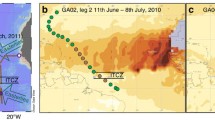Abstract
Today, the global lead emissions into the atmosphere from anthropogenic sources are about 200 times higher than in the past1 and dominate other lead pathways to the ocean. Exhaust from leaded gasoline is the major source of pollutant lead in the atmosphere2, and subsequently in the marine environment due to atmospheric deposition by wet and dry removal processes3,4. This pollution has already perturbed the biogeochemical cycle of lead in the open ocean2,3,5–7 especially in the north Atlantic. In surface waters, where lead is introduced mainly in the dissolved state, its residence time is relatively short (less than 5 years), as it is rapidly scavenged by, and transported with, participate matter5,7. The mean residence time of lead in the ocean is estimated to be ∼100 yr5,8. One can therefore expect to see some pollutant lead in the deep ocean surficial sediments. Here, we report lead concentrations in two short cores from the north-east Atlantic. Lead concentrations in surficial sediments (21.0 and 15.0 p.p.m. in the top cm) are higher than in the uppermost 10 cm of the cores (6.0 and 2.8 p.p.m.), and are likely to be enhanced from anthropogenic sources. The quantity of lead stored in these surficial sediments (5.7 and 2.5 µg cm−2) is of the same order as the amount of pollutant lead present in the dissolved state in the water column.
Similar content being viewed by others
Author information
Authors and Affiliations
Rights and permissions
About this article
Cite this article
Veron, A., Lambert, C., Isley, A. et al. Evidence of recent lead pollution in deep north-east Atlantic sediments. Nature 326, 278–281 (1987). https://doi.org/10.1038/326278a0
Received:
Accepted:
Issue Date:
DOI: https://doi.org/10.1038/326278a0
- Springer Nature Limited
This article is cited by
-
Sediment fluxes and the littoral drift along northeast Andhra Pradesh Coast, India: estimation by remote sensing
Environmental Monitoring and Assessment (2013)
-
Hydrochemical, and Pb- and Sr- isotopic constraints on the precipitation and dilution of metals in acidified mine water: an example from the abandoned Dongjin Au-Ag-Cu mine, Korea
Geosciences Journal (2008)
-
Reconstruction of pollutant lead invasion into the tropical North Atlantic during the twentieth century
Coral Reefs (2006)
-
Continental origin and industrial sources of trace metals in the Northwest Atlantic troposphere
Journal of Atmospheric Chemistry (1992)





